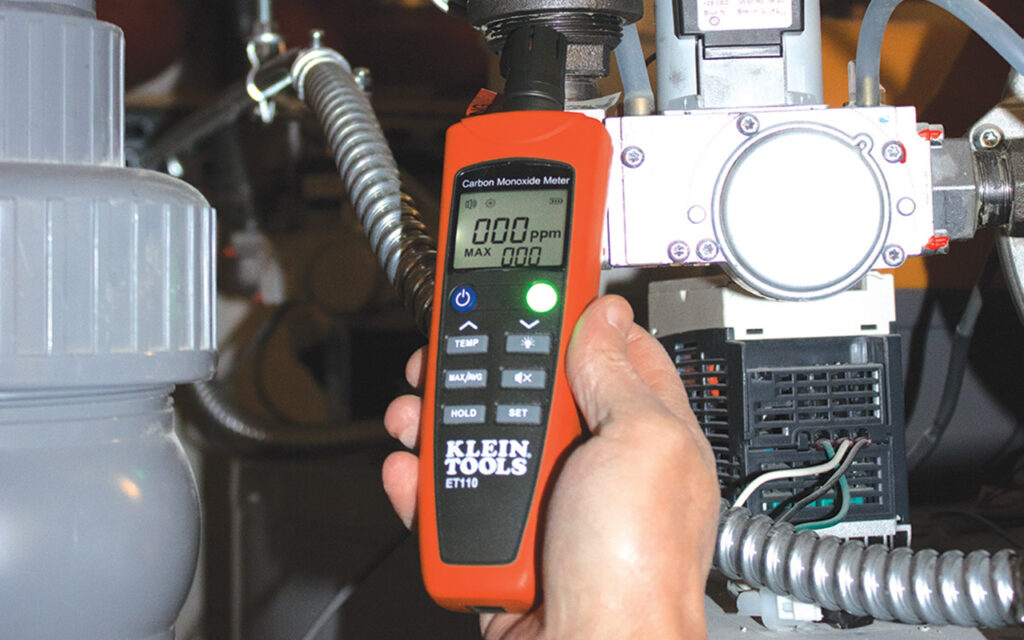
The Brooding Notebook: High CO levels a silent threat
By Dr. Gigi Lin
Features BroilersElevated carbon monoxide levels can be an unseen threat that impacts broiler performance. Here's what one investigation found.
 A handheld carbon monoxide monitor can detect an unseen threat to your flock.
Photo: Klein Tools
A handheld carbon monoxide monitor can detect an unseen threat to your flock.
Photo: Klein Tools Case Summary: In the October 2023 issue, I shared a case that highlighting the impact of high levels of carbon dioxide on poultry health. In this issue, I would like to address another, even more dangerous and often-overlooked, toxic gas that can cause significant health impacts to poultry. This report details a case of suboptimal performance in three consecutive flocks of broilers, ultimately traced back to poor air quality in the barn.
Case History: It was early Spring in B.C. while I was working closely with a conventional broiler farm in Abbotsford. It was a well-managed family farm with an experience farm manager. I was consulted to investigate an on-going complaint of generalized poor performance, including poor feed conversion, poor uniformity, and failure to reach target body weights for three consecutive flocks.
Recent performance data showed that the average body weights of birds started to fall off the baseline as early as seven days old. However, there were no other clinical signs reported; the mortality levels and condemnation rates had been normal.
Diagnostic Approach: The investigation began with routine portmortem examinations and end-of-flock serology tests (a series of blood tests that help identify exposure to disease-causing agents) to help rule out underlying disease conditions. All the results came back insignificant. Routine intestinal health check was also performed, including coccidia lesion scoring. I did not find any prominent infectious disease conditions. The feed company also ran multiple feed analyses and did not identify any nutritional imbalance or deficiency.
Field Evaluation: When I received the initial complaint, the existing flock was in the grow-out phase. I went to the farm twice between the grow-out and finisher phases and did not identify any management or environmental stressors that could have explained the problems.
Unable to identify the underlying causes, I decided to shift the focus on the brooding period, which is the critical phase for establishing optimal conditions for chick growth and development. I went to the farm at different time every day between day one to day five to go through the brooding checklist (TFLAWS: temperature, feed, litter, air, water, and sanitation).
With the farm manager’s help, we monitor the birds’ weight once a day by randomly selecting 100 chicks. By day four, we started to notice birds fell off the trajectory weight gain despite normal brooding parameters. At that time, I decided to return with a handheld carbon monoxide (CO) monitor. To everyone’s surprise, I found elevated CO levels ranging from 20 to 50 ppm throughout the barn, likely contributed to the suboptimal performance over the last few flocks.
The Dangers of Carbon Monoxide: CO is a colourless, odorless gas that poses a serious threat to both poultry and human health. At high levels and prolonged exposure, CO can cause death in humans and animals. Most reported CO cases in poultry have been related to prolonged exposure at low level due to poorly functioning brooders. It is a more common problem in the winter when the heating systems are running for long hours in under-ventilated barns.
CO has strong binding affinity to hemoglobin in blood, therefore replacing the transport of oxygen and prevent transport of oxygen from the lungs to body tissue. For this reason, birds’ growth can be impacted because normal growth and body function require a lot of oxygen, especially during the rapid growth period in the first week of life. Prolonged exposure to low level of CO can also contribute to a higher incident of ascites syndrome at older ages.
Clinical Outcome: Upon identifying the elevated CO levels, the farm manager increased ventilation immediately and sought professionally help to identify the source of CO emissions, which was later identified as a few faulty brooders, to ensure that the barn environment was safe for both poultry and farm personnels. Subsequent flocks showed improved general performance after proper maintenance and repair of the brooders.
Lessons Learned: Proper maintenance of heating systems, including regular inspections and timely repairs, is essential for minimizing the risk of CO exposure. This case also highlights the importance of evaluating environmental factors thoroughly. Particularly when evaluating air quality in the barn, other than the dust levels, air temperatures, drafty spots, do not forget to look for harmful gases such as carbon monoxide, carbon dioxide, and ammonia.
Dr. Gigi Lin is a board-certified poultry veterinarian. She provides diagnostic, research, consultation, continuing education, and field services to all levels of the poultry industry in Western Canada. In this column, she will share case-based reviews of brooding best practices.
Print this page